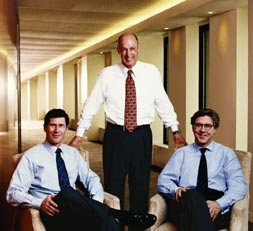
FROM LEFT
John A. Thain
President and
Co-Chief Operating Officer
Henry M. Paulson, Jr.
Chairman and
Chief Executive Officer
John L. Thornton
President and
Co-Chief Operating Officer
|
 |

Our people want to make a difference. They see globalization as a force for good and are proud of the dynamic role that Goldman Sachs plays in shaping the world economy.
It is no easy task to maintain our culture in the face of great growth and change. To meet this challenge, in 1999 we initiated a multiyear process to adapt our culture to a large and growing global organization without becoming bureaucratic. As we became larger, we recognized that many of our processes—recruiting, mentoring, training, performance evaluation, career development—had to be reengineered.
In the "old days," each business manager was his or her own Human Resources professional, and much of the training and career development was done on an apprenticeship basis. This doesn't work quite as well anymore. Over the last several years, we have made some real progress in adapting our people-management capabilities to a larger organization in "Pine Street" (named after the address of the original Goldman Sachs headquarters).
| • | We are 12 months into a highly promising leadership development program for our Managing Directors, headed by the former Director of the G.E. Crotonville Executive Educational Program. |
| • | We are doing a better job of continually communicating with our people on firmwide, divisional and business-unit levels. |
| • | We have continued to strengthen our performance evaluations, mentoring and training programs throughout the firm. |
| • | We have recently taken actions to intensify and strengthen a 21st century Diversity Program in the context of a global institution. |
| • | We continue to expand our Community TeamWorks Program. This year, over 18,000 of our people around the world worked together in teams to give energy and creativity to nonprofit organizations in the communities in which they work. |
These and other measures to manage our growth are ongoing. They are clearly only part of what must be a long-term, broad-based commitment to strengthening our culture. Making—and keeping—that commitment will be critical as we work toward our goal of becoming the world's preeminent investment banking, securities and investment management company.
Of course, we recognize that a corporate culture is not an end in itself but a means to an end. It enables us to execute successfully a winning business strategy that results in extraordinary client service and superior long-term financial performance for our shareholders. Like everyone in our industry, we faced considerable adversity in the form of difficult market conditions in 2001. We have noted in the past that we do not expect a predictable, stable pattern of quarter-over-quarter earnings increases. In fact, while we believe our business offers attractive long-term returns, 2001 provided an excellent reminder that fluctuating markets mean that our business will never have the stability of some other sectors.
We continually tell our people that although we cannot do anything to change the environment, we can strive to outperform the competition and meet the high expectations of our clients. From that perspective, 2001 was a highly successful year. The quality of our people and culture, together with the strength and diversity of our businesses, was evident as we produced an 18% return on our tangible equity in one of the most challenging years in our industry's history.
|
 |
